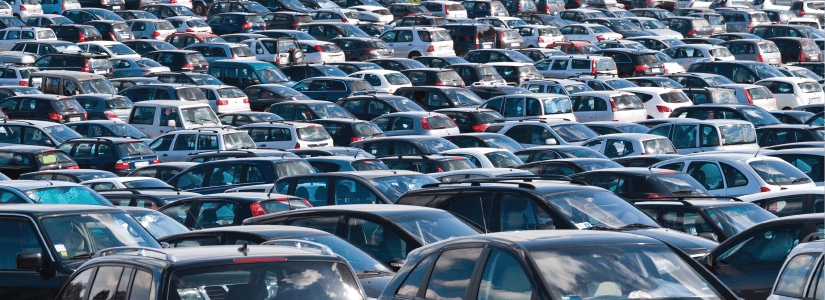
Solving the mystery of Europe’s ghost fleet
17th Oct, 2019
The spooky season is just beginning – now’s the time when the UK falls in love with haunting tales and chilling bedtime stories. We certainly know something that’s keeping people at the European Commission up at night; it’s Europe’s mysterious ‘ghost fleet’. No, it’s not an ethereal group of motors gliding silently through the night. The truth is a little more mundane, but no less terrifying. Every year, 3 to 4 million cars go missing in Europe. For whatever reason, something’s going wrong when certain people decide ‘I need to scrap my car’. So, what’s the extent of the problem, and what’s being done to tackle it?
The missing cars
Every year, about 10 million cars are deregistered and scrapped in Europe. Or at least, they’re supposed to be. In actuality, only about two thirds of them are successfully processed. According to the European Commission, the rest just vanish. The missing cars typically number between 3 to 4 million a year, but this hit a high of 4.7 million cars in 2014.
This is a big problem for a number of reasons. First of all, it means that the EU falls far short of its car recycling targets, and millions of tonnes of metal, plastic, rubber and glass aren’t properly repurposed. That’s not to mention the fluids; somewhere between 20 million to 55 million litres of hazardous liquids also vanish. It’s overwhelming likely that lots of these fluids not being disposed of properly, which poses a serious environmental hazard.
Environmental hazards aside, missing cars can also pose financial risks and even a physical danger to motorists, mainly due to unscrupulous dealers. As we’ve covered before, a car scrapped without a proper Certificate of Destruction means that the DVLA still probably views the original owner as being legally responsible for it. That means if it’s later pulled up for traffic offences, or even used in a crime, the original owner is landed with the consequences. In fact, the illegal scrap car trade often fuels the world of organised crime, as ‘ghost’ cars are often used for crash-for-cash schemes or armed robberies, or bought and sold to fund further criminal enterprises.
Those are just a couple of the most pressing issues, all of which the European Commission will take into account when it reviews its End of Life Vehicle Directive in 2020. In less than a year, it will evaluate the current situation, and how it can progress from here.
What’s happening to the ghost cars?
The data isn’t entirely clear, which is a big part of the problem. Sometimes, it’s a case of missing paperwork or human error. For example, if a car is sold abroad as a secondhand vehicle, but never deregistered in its country of origin, then it becomes two vehicles on paper, creating a ‘ghost car’ that has never actually existed.
Sometimes, flawed systems or rules can facilitate these sorts of errors. Germany drew some raised eyebrows with one particular system, in which cars that were not used for seven years were automatically and permanently deleted from its central vehicle registry. That left cars that still physically existed, but no obligation for the owners to report on their status.

About 5% of them are stolen and never recovered. Many of these stolen cars are exported to developing countries, where a European scrap car can be cheaply repaired and sold on for a quick buck.
The majority are assumed to be illegally dismantled, either internationally or domestically. This poses a clear and present danger to honest motorists – instead of unroadworthy cars being scrapped, thousands of them cars are being hastily repaired to become incredibly dangerous cut and shuts, sold back to unsuspecting drivers.
And as we touched on above, illegal scrap car dealers have direct links to petty and organised crime. In particular, the willingness of some dealers to accept metal and components ‘no questions asked’ is regarded as a major factor in the rate of catalytic converter thefts, which has skyrocketed in 2019. (As many as 2894 were stolen in just the first six months of 2019, compared to just 1674 were in all of 2018.)
How are we tackling the ghost fleet problem?
UK authorities are being highly proactive in their efforts to tackle illegal dismantling – significantly so, compared to other countries. While France had a crackdown in 2013 that resulted in the closure of 100 illegal scrap yards, the UK successfully closed down 989 in 2015. Both countries report relatively low shares of missing ‘ghost’ vehicles compared to Europe’s wider fleet, and illegal traders caught in England are frequently fined thousands of pounds.
Italy and Spain aren’t doing quite as well – more than half a million cars in each country go missing every year. That amounts to more than a third of the total cars scrapped. Germany, on the other hand, took steps to rectify its paperwork loopholes by carrying out a major review in 2017, sorting out which cars had incorrect paperwork and which ones were genuinely missing. The tally of 1.2 million cars was eventually brought down to 350,000.
For its part, a European Commission report recommended standardising the rules for registration and deregistration at the EU level. It’s already encountered resistance from its member states, though, many of whom are defending their current systems. And with the UK in the midst of leaving the European Union, who knows if any when our own system will come to evolve?
Thankfully, here at Scrap Car Network we can guarantee your car will be scrapped responsibly. Every one of our partners is licenced and monitored as an Authorised Treatment Facility, where at least 95% of your car is recycled according to EU law. We won’t partner with anyone else! What’s more, we’ve stripped back our systems so that it’s never been easier to scrap your car – all you need is a free, no obligation quote to get started. Want to find out how much your car is worth?